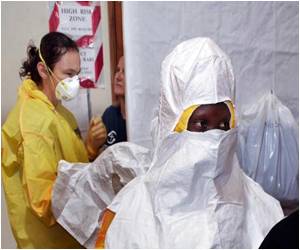New research suggests that reducing community transmission and changing behavior in communities is key to containing Ebola outbreaks.

The study authors include Professor Peter Piot and Dr Joel Breman, who travelled to Zaire (now the Democratic Republic of Congo), to investigate the first outbreak in 1976. The study, published in Epidemics, also found that if the people in the affected community had not changed their behaviour in 1976, the outbreak could have been much larger – potentially as large as the current outbreak in Liberia, Sierra Leone and Guinea.
Previous analysis of the outbreak has looked at the overall number of cases over time, but this is the first time that researchers have been able to quantify the contribution of hospital-based transmission (via contaminated syringe) and community transmission (person-to-person transmission via infection from an infected living or dead patient in the community) to Ebola transmission during the outbreak.
Dr Adam Kucharski, Research Fellow in Infectious Disease Epidemiology at the London School of Hygiene & Tropical Medicine, and joint lead author on the study, said: "This is the first time that it has been possible to calculate how transmissible Ebola is in the community, and it gives us a better understanding of where transmission occurs, and where infection needs to be controlled."
"Our results suggest that changes in behaviour, such as changing traditional funeral practices to avoid catching the virus from infected corpses, led to effective reduction in person-to-person transmission in the community and were essential in reducing the potential size of the 1976 outbreak. If the reduction in community transmission had been smaller then the outbreak could have persisted for much longer."
The researchers revisited original patient data from the 1976 outbreak, including Prof Piot's handwritten notes. The data included information about the likely source of infection, as well as date of infection onset, and whether the patient recovered or died from the virus.
Advertisement
By analysing detailed data for 262 of the cases and using a mathematical model, the researchers showed that the reproduction number (the average number of secondary cases produced by an infectious person) associated with community transmission was above one at the start of the 1976 outbreak. A reproduction number of more than one means an infection will spread in a population and has the potential to become an epidemic.
Advertisement
Dr Anton Camacho, Mathematical Modeller at the London School of Hygiene & Tropical Medicine, and joint lead author on the study, added: "Crucially, we can see that this behaviour change happened quickly - within a few weeks. In the current outbreak we have not seen this big trend in changing behaviour in communities; the response has been slower, perhaps due to the outbreak affecting different geographical areas and urban centres as well as rural communities."
Peter Piot, now Director and Professor of Global Health at the London School of Hygiene & Tropical Medicine, said: "This study highlights that Ebola is not something you can just contain with hospital-based measures alone. Getting the message out into the community and getting people to change their behaviour is critical if we are to bring the current outbreak under control. Measures such as isolating patients, contact tracing and follow-up surveillance, and community education are all part of the response."
"As well as a huge international response, in-country efforts are needed to address the fear and mistrust of health workers and governments. We are a long way off catching up with the current outbreak, and even further from being in control of it."
The authors note that variations in social and cultural factors between different regions, as well as the unpredictable nature of Ebola outbreaks, mean that we should be cautious when applying the study findings to other settings. They are making the 1976 data publically available to enable further studies, which they hope will give more insight into factors contributing to the outcome of Ebola outbreaks and which control measures are most effective.**
Source-Eurekalert










